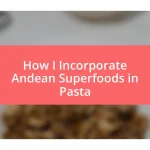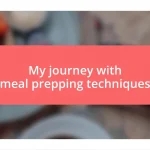Key takeaways:
- Sous-vide cooking offers precision in temperature control, enhancing flavors and ensuring uniform cooking results.
- Using high-quality ingredients and understanding the right cooking times are crucial for maximizing the sous-vide experience.
- Common troubleshooting techniques, like ensuring uniform thickness of proteins and preventing floating bags, can greatly improve cooking outcomes.
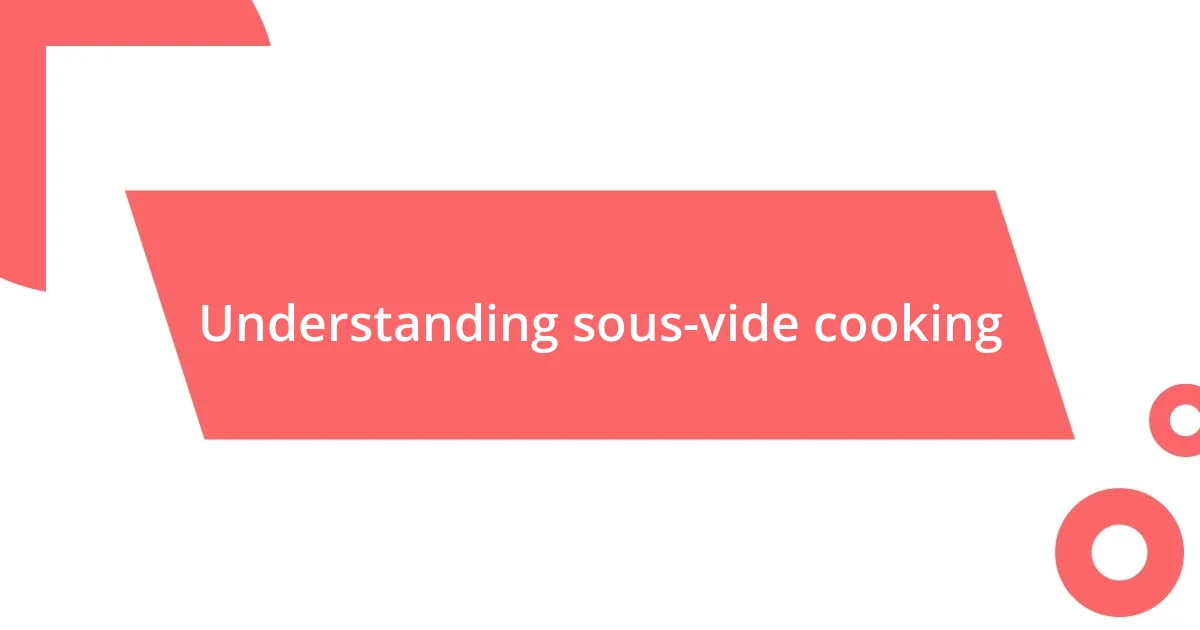
Understanding sous-vide cooking
Sous-vide cooking is a method that involves sealing food in a vacuum bag and immersing it in a water bath at a precisely regulated temperature. I remember the first time I tried this technique; I was amazed by how tender and flavorful the steak turned out. It’s like creating a little magic in your kitchen! Doesn’t it sound tempting to know that you can achieve restaurant-quality meals at home?
The beauty of sous-vide lies in its precision. Unlike traditional cooking methods, where temperature control can be a guessing game, sous-vide allows for exact temperature settings, ensuring the food is cooked uniformly. Imagine enjoying a perfectly cooked egg that’s creamy and custard-like throughout. Have you ever experienced the disappointment of overcooked eggs? With sous-vide, that worry is behind you!
Another factor that makes sous-vide so appealing is the way it enhances flavors. When food is vacuum-sealed, it retains moisture and intensifies its natural flavors, leading to a delightful dining experience. I still recall the rich aroma that filled my kitchen when I cooked vegetables this way; it’s a sensory journey worth taking. Have you considered how much more vibrant your favorite ingredients could taste through this method?
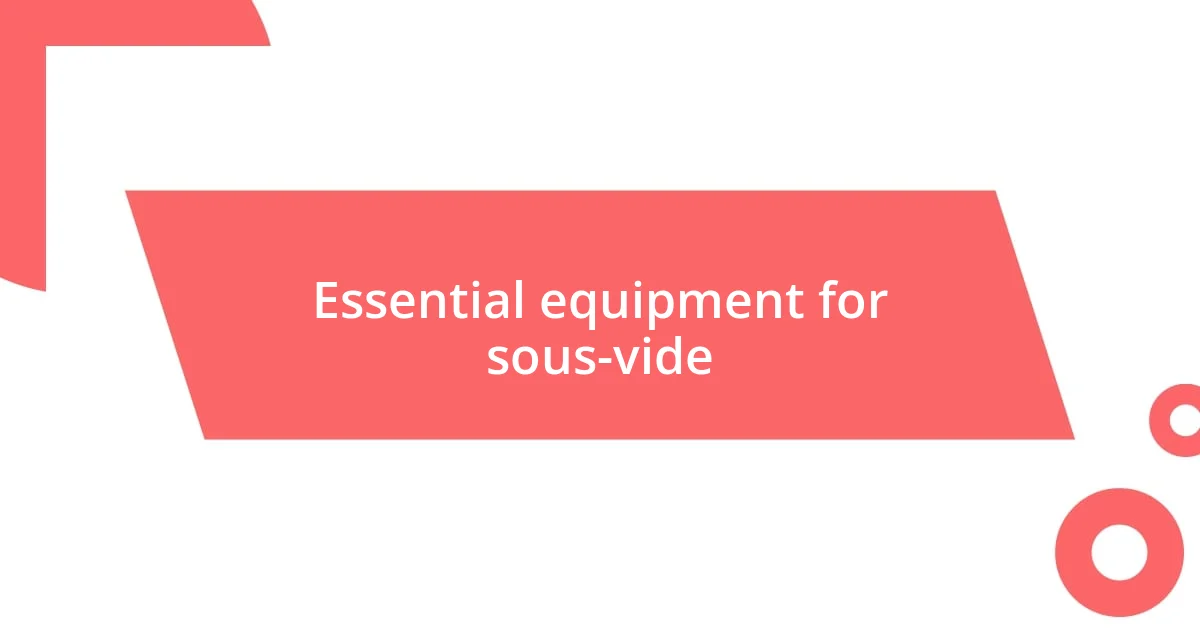
Essential equipment for sous-vide
When it comes to sous-vide cooking, the right equipment is everything. A sous-vide immersion circulator is the heart of this technique. I still remember the thrill of unboxing my first one; it felt like opening a gateway to culinary adventure. The precision of the circulator ensures that water temperature stays consistent, allowing for perfectly cooked meals every time.
In addition to the circulator, durable vacuum-seal bags are essential. They prevent water from entering while ensuring that your food is heated evenly. I often think back to the time I used cheap bags; they leaked, ruining a beautiful filet mignon. Investing in quality bags made all the difference in the world, not only in terms of food safety but also in taste.
Don’t overlook a reliable container for your water bath. I prefer to use large stock pots, but there are dedicated sous-vide containers available too. A sturdy container minimizes water evaporation and keeps the cooking environment stable. Have you ever pulled off a successful meal and felt nothing but pride? It’s those moments, like perfecting a duck breast, that keep me coming back to this satisfying method.
| Equipment | Purpose |
|---|---|
| Sous-vide immersion circulator | Maintains precise water temperature |
| Vacuum-seal bags | Seal food for even cooking without water ingress |
| Water bath container | Holds the water and minimizes evaporation |
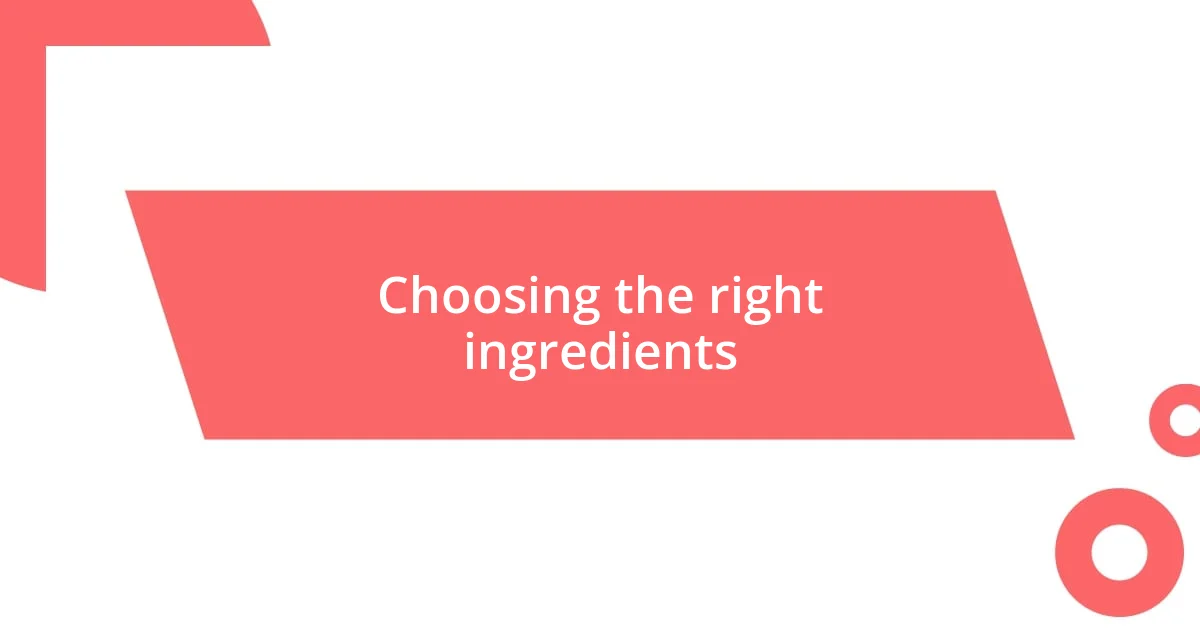
Choosing the right ingredients
Choosing the right ingredients is a game-changer for your sous-vide experience. I have found that fresh, high-quality ingredients can elevate a simple dish to extraordinary heights. The first time I used organic vegetables from my local farmer’s market, I was blown away by the contrast in taste. They almost seemed to dance with flavor, transforming a standard side dish into a highlight of the meal.
When selecting your ingredients, consider their quality and freshness. This choice significantly affects the final outcome. Remember, sous-vide cooking amplifies natural flavors, so using the best ingredients matters. Here are some quick tips for choosing the right ones:
- Select seasonal produce: This often means fresher ingredients that are bursting with flavor.
- Opt for grass-fed or pasture-raised meats: They tend to have better taste and texture.
- Look for marbling in cuts of meat: This indicates higher fat content, resulting in juicier and more flavorful dishes.
- Always check for ripeness with fruits: They should feel firm but slightly give when gently pressed.
- Consider herb quality: Fresh herbs can elevate your dish; try to use whole sprigs rather than dried versions for the best flavor infusion.
The next time you’re at the grocery store or market, take a moment to really inspect your ingredients. Trust me, the effort you put into sourcing them pays off handsomely when it’s time to indulge in the finished product!
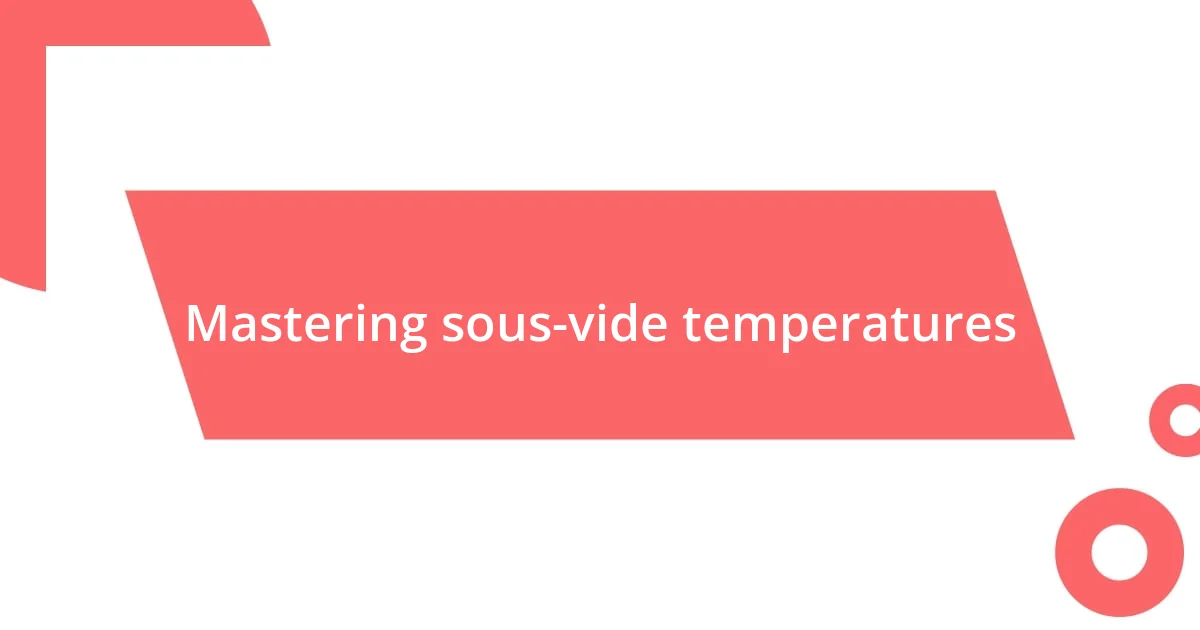
Mastering sous-vide temperatures
Mastering sous-vide temperatures is a thrilling part of the cooking journey. I recall the first time I experimented with sealing a steak at 130°F (54°C). It emerged perfectly medium-rare, but what amazed me even more was how different the texture felt compared to traditional grilling. That experience taught me the magic of precision; one degree can make all the difference.
What I’ve learned over time is that understanding the right temperatures for various foods really enhances your culinary repertoire. Did you know that while chicken is safe to eat at 165°F (74°C), it can also become exceptionally tender and juicy at just 140°F (60°C) if cooked for long enough? It’s a revelation that shifted my approach entirely. Now, I often find myself exploring the depths of sous-vide, pushing boundaries that I once thought unfathomable.
Consistency is key in sous-vide cooking, and I can’t stress enough how invaluable a reliable immersion circulator is. I remember one occasion when I mistakenly set my circulator to an incorrect temperature—life lesson, right? The result was a strangely chewy pork chop. That mishap reinforced my respect for temperature control, sparking a newfound determination in my sous-vide practice. It’s a reminder that mastering these temperatures is not just about following instructions; it’s about embracing the science and art behind perfect dishes.
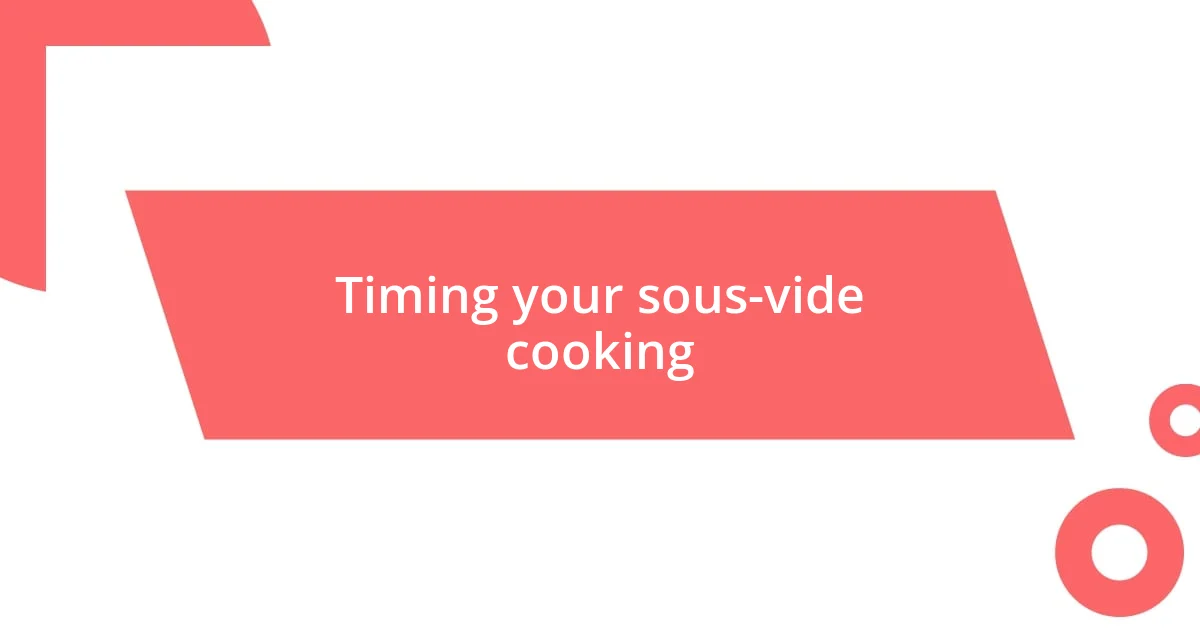
Timing your sous-vide cooking
Timing is everything when it comes to sous-vide cooking, and I’ve had my fair share of lessons in this area. Initially, I’d often underestimate how long certain proteins required to reach that perfect tender state. One memorable evening, I cooked a chuck roast for only eight hours because I was excited to dig in. While it was tasty, I later learned that a full 24 hours truly unlocks that melt-in-your-mouth quality. It’s fascinating how sous-vide can transform tough cuts into culinary masterpieces with just a little more patience.
I’ve also discovered that different ingredients not only require varying temperatures but also different cooking times. For instance, the first time I prepared asparagus, I set it for just 30 minutes, eager to maintain its vibrant color. What I didn’t consider was that a full hour would elevate its flavor and texture significantly. Have you ever experienced an ingredient that exceeded your expectations? For me, it was that perfectly cooked vegetable; it became a staple at my dinner parties. Now, I make a point to consult timing charts, and I can confidently adjust my approach based on what I’m cooking.
In the end, sous-vide isn’t just about precise temperatures; it’s about knowing how long to keep ingredients in the water bath. I often find myself planning meals around cooking times, allowing me to set up everything in advance. It’s empowering to feel in control of my kitchen, and great timing truly allows flavors to shine and delivers an exceptional dining experience. So, ask yourself: how can mastering your timing transform your meals? It’s a journey that continually rewards me, and I hope it does the same for you!
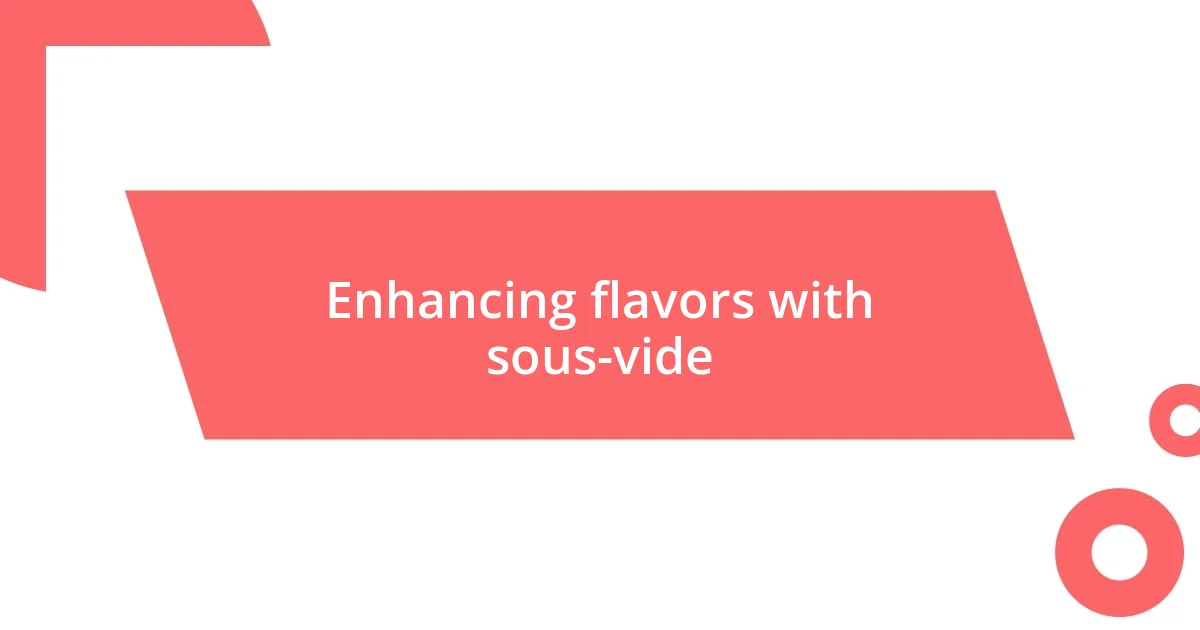
Enhancing flavors with sous-vide
When it comes to enhancing flavors with sous-vide, I’ve found that the method really allows ingredients to shine in ways I never expected. I remember the first time I infused herbs directly into my sous-vide pouch; I used rosemary with a chicken breast and vacuum-sealed it all together. The result? A subtle yet profound herbal note that completely elevated the dish! It was as if the chicken had absorbed the essence of the rosemary, making every bite burst with flavor.
I’ve also experimented with marinating proteins before sealing them, and the difference can be remarkable. One evening, I marinated a flank steak in a mixture of soy sauce and garlic for a few hours before cooking it sous-vide at 140°F (60°C) for an extended time. The meat became not just tender but rich with that savory garlic flavor that permeated every single fiber. Isn’t it amazing how you can transform a cut of meat just by infusing it beforehand?
The beauty of sous-vide is that you can achieve flavors you might think are only possible through complex cooking methods. I often think about how sous-vide lets you play with temperature and time while achieving maximum flavor without constant monitoring. It’s almost like an adventure in your kitchen—each meal becomes a canvas for creativity and exploration. Have you ever experienced that burst of joy when a dish you’ve created exceeds all expectations? For me, it keeps me eager to experiment, knowing that the next meal could be even more delicious than the last!

Troubleshooting common sous-vide issues
I’ve encountered a few hiccups with sous-vide that turned into valuable learning moments. One time, I opened my vacuum-sealed bag only to find that the meat hadn’t cooked evenly. It was a bit disheartening, but after some research, I realized that the thickness of the protein really impacts cooking. Now, when I cook steaks, I always ensure they’re a uniform thickness so that every bite has that perfect doneness.
Another common issue I’ve faced is the dreaded float. Picture this: I’m ready to relax, and then I notice that my chicken breast is bobbing to the surface of the water bath. It’s frustrating because the part exposed to the air won’t cook correctly. I’ve found that using clips to secure the bag to the side of the container works wonders. Have you ever faced a similar predicament? I can tell you, those clamps became my best friends!
Lastly, timing isn’t the only thing to watch out for; water temperature can give you grief too. I once cooked a pork loin at what I thought was the right temperature, only to discover it wasn’t as tender as I anticipated. Upon reflection, I realized my immersion circulator wasn’t fully calibrated. Since then, I’ve taken the time to regularly check its accuracy. It’s amazing how even minor adjustments can lead to that perfect, fall-apart tenderness we all crave. So, how do you troubleshoot potential pitfalls in your cooking? For me, these little bumps in the road have only made me a more confident cook!




